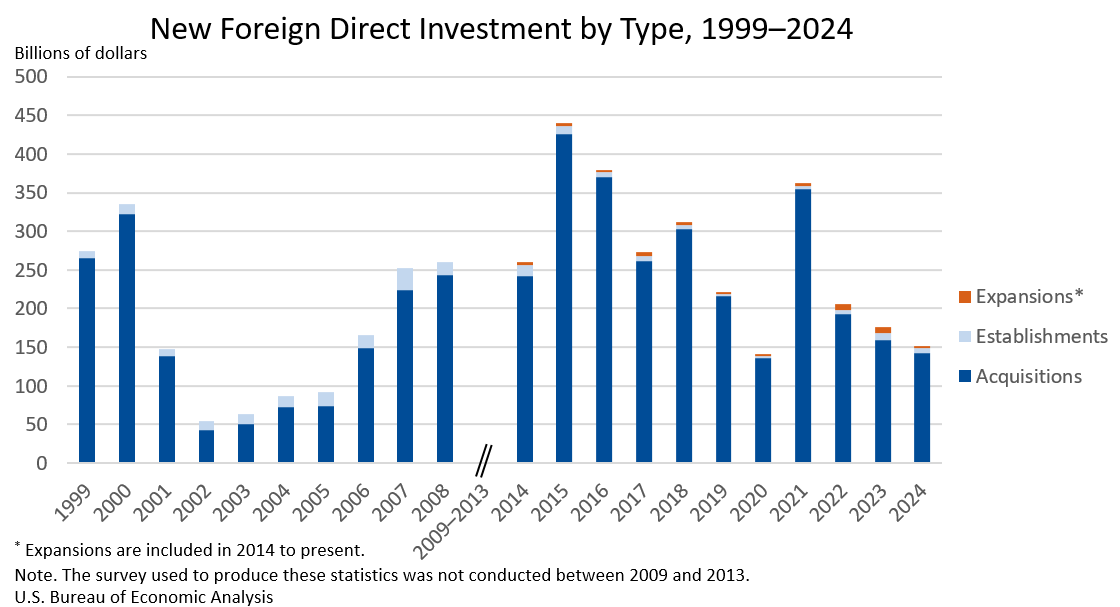Bureau of Economic Analysis
New Foreign Direct Investment in the United States, 2024
Expenditures by foreign direct investors to acquire, establish, or expand U.S. businesses totaled $151.0 billion in 2024, according to preliminary statistics released today by the U.S. Bureau of Economic Analysis. Expenditures decreased $24.9 billion, or 14.2 percent, from $176.0 billion (revised) in 2023 and were below the annual average of $277.2 billion for 2014–2023. As in previous years, acquisitions of existing U.S. businesses accounted for most of the expenditures.
Principal Federal Economic Indicators
Noteworthy
- 2025 News Release Schedule
- Innovation at BEA
- 2025 Annual Updates
- New! Services Trade Data for More Countries
- Data Tool: Trade in Value Added
- Distribution of State Personal Income
- Updated: RIMS II Regional Multipliers
- Arts and Culture
- Space Economy
- FDI Now in State BEARFACTS
- Quick Guide: Price Indexes
The Latest
Personal Income and Outlays, August 2022 and Annual Update
Personal income increased $71.6 billion, or 0.3 percent at a monthly rate, while consumer spending increased $67.5 billion, or 0.4 percent, in August. The increase in personal income primarily reflected increases in compensation and proprietors’ income. The personal saving rate (that is, personal saving as a percentage of disposable personal income) was 3.5 percent in August, the same rate as in July.
Personal Income and Outlays, August 2022 and Annual Update
Personal income increased $71.6 billion, or 0.3 percent at a monthly rate, while consumer spending increased $67.5 billion, or 0.4 percent, in August. The increase in personal income primarily reflected increases in compensation and proprietors’ income. The personal saving rate (that is, personal saving as a percentage of disposable personal income) was 3.5 percent in August, the same rate as in July.
Gross Domestic Product (Third Estimate), Corporate Profits (Revised Estimate), and GDP by Industry, Second Quarter 2022 and Annual Update
Real gross domestic product (GDP) decreased at an annual rate of 0.6 percent in the second quarter of 2022, following a decrease of 1.6 percent in the first quarter. The second-quarter decrease was the same as previously estimated in the “second” estimate released in August. The smaller decrease in the second quarter, compared to the first quarter, reflected an upturn in exports and an acceleration in consumer spending. For more details,…
Gross Domestic Product (Third Estimate), GDP by Industry, and Corporate Profits (Revised), 2nd Quarter 2022 and Annual Update
Real gross domestic product (GDP) decreased at an annual rate of 0.6 percent in the second quarter of 2022, following a decrease of 1.6 percent in the first quarter. The second-quarter decrease was the same as previously estimated in the “second” estimate released in August. The smaller decrease in the second quarter, compared to the first quarter, reflected an upturn in exports and an acceleration in consumer spending. Profits increased 4.6…
U.S. International Investment Position, 2nd Quarter 2022
The U.S. net international investment position, the difference between U.S. residents’ foreign financial assets and liabilities, was –$16.31 trillion at the end of the second quarter of 2022, according to statistics released today by the U.S. Bureau of Economic Analysis (BEA). Assets totaled $30.98 trillion, and liabilities were $47.29 trillion. At the end of the first quarter, the net investment position was –$17.75 trillion.
U.S. International Investment Position, 2nd Quarter 2022
The U.S. net international investment position (IIP), the difference between U.S. residents’ foreign financial assets and liabilities, was -$16.31 trillion at the end of the second quarter of 2022, according to statistics released today by the U.S. Bureau of Economic Analysis (BEA). Assets totaled $30.98 trillion, and liabilities were $47.29 trillion. At the end of the first quarter, the net investment position was -$17.75 trillion.
U.S. International Transactions, 2nd Quarter 2022
The U.S. current-account deficit narrowed by $31.5 billion, or 11.1 percent, to $251.1 billion in the second quarter of 2022, according to statistics released today by the U.S. Bureau of Economic Analysis. The revised first-quarter deficit was $282.5 billion. The second-quarter deficit was 4.0 percent of current-dollar gross domestic product, down from 4.6 percent in the first quarter.
U.S. Current-Account Deficit Narrows in 2nd Quarter 2022
The U.S. current-account deficit, which reflects the combined balances on trade in goods and services and income flows between U.S. residents and residents of other countries, narrowed by $31.5 billion, or 11.1 percent, to $251.1 billion in the second quarter of 2022. The narrowing mostly reflected a decreased deficit on goods. The second-quarter deficit was 4.0 percent of current-dollar gross domestic product, down from 4.6 percent in the…
BEA Updating 2017-22 Statistics With Latest Data
At the end of September, BEA will update five years of U.S. gross domestic product and related statistics, as well as GDP statistics for industries and for each state.
These updates are part of a cycle the U.S. Bureau of Economic Analysis follows to continue refining its statistics as more information becomes available. The annual updates incorporate data that only become available yearly, such as from the Census Bureau’s annual…
July 2022 Trade Gap is $70.6 Billion
The U.S. monthly international trade deficit decreased in July 2022 according to the U.S. Bureau of Economic Analysis and the U.S. Census Bureau. The deficit decreased from $80.9 billion in June (revised) to $70.6 billion in July, as exports increased and imports decreased. The previously published June deficit was $79.6 billion. The goods deficit decreased $8.2 billion in July to $91.1 billion. The services surplus increased $2.1 billion in…




